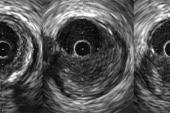More Angina Relief With Complete Revascularization in Stable CAD: ISCHEMIA
(UPDATED) One doctor says these results may shift his thinking in stable CAD. Another argues it doesn’t change ISCHEMIA’s message.

Complete revascularization with PCI results in better health status for patients with multivessel, stable CAD than either incomplete revascularization or a conservative strategy of guideline-directed medical therapy (GDMT) alone, a new analysis from ISCHEMIA shows.
The benefit of complete revascularization—which was achieved in roughly 50% of patients who underwent PCI—was most pronounced in patients with daily or weekly angina at baseline, report investigators.
“In the overall ISCHEMIA trial, it did show that revascularization on top of medical therapy improved symptoms compared with no revascularization,” lead investigator Kreton Mavromatis, MD (Atlanta VA Medical Center, Decatur, GA), told TCTMD. “That benefit wasn’t seen in the patients with no or very infrequent angina [at baseline] in the original trial. So, this study goes on to show that in the subgroup of symptomatic patients—particularly the most symptomatic patients, ie, those with weekly or daily angina—focusing our revascularization efforts on them is particularly important, both in terms of any revascularization as well as trying to achieve completeness.”
Mavromatis said that in a symptomatic patient with multivessel CAD, operators need to “step back” to ask themselves if they can safely take care of all lesions in order to provide the patient with the best possible health outcomes.
“That means the heart team is reemphasized,” he said, noting that some patients may require specialized care with operators skilled in treating chronic total occlusions (CTOs). “You may also want to think about bypass surgery, because there are other vessels that aren’t great angioplasty targets. It tells us that we definitely need to focus on taking care of not only the low-hanging fruit but clearing the whole tree.”
Shamir Mehta, MD (McMaster University/Population Health Research Institute, Hamilton, Canada), who led the COMPLETE trial looking at complete revascularization in ACS patients, said the new analysis comparing complete and incomplete revascularization is observational and nonrandomized, which makes it challenging to infer a treatment effect of complete revascularization.
“Although they did a good job with statistical adjustments and showed an apparent benefit of complete versus incomplete revascularization on quality of life, the data are observational and need to be interpreted with caution,” he said. “It is reassuring that patients with more severe angina had a greater treatment effect, but given the nonrandomized nature of this comparison, I’m not sure how to interpret it clinically. I certainly don’t think this analysis should be used to say that complete revascularization should be performed on a preventive basis in all patients with stable ischemic heart disease,” said Mehta.
It tells us that we definitely need to focus on taking care of not only the low-hanging fruit but clearing the whole tree. Kreton Mavromatis
Kevin Bainey, MD (Mazankowski Alberta Heart Institute/University of Alberta, Edmonton, Canada), also was cautious in interpreting the results, though he believes the study suggests a potential benefit when it comes to quality of life.
“It is an association, but it’s helpful,” Bainey told TCTMD. “Right now, based on what we know from ISCHEMIA, the patients coming to the cath lab with chronic coronary syndromes are really the ones who have symptoms. When they do come with symptoms, in those with multivessel disease, this analysis helps direct us toward the fact we should be trying to achieve complete revascularization to improve angina-related health status. The analysis also clearly shows that the patients who benefit are those with a lot of angina at baseline.”
For the stable patient coming into the lab with infrequent angina, “this also tells us that you don’t need to be aggressive with trying to achieve complete revascularization because those benefits are markedly attenuated,” said Bainey.
Focusing on Symptom Improvement
The study, which was published July 17, 2023, in the Journal of the American College of Cardiology, focuses on patients in the invasive arm of the ISCHEMIA trial, a landmark study that showed the strategy of adding revascularization with PCI or CABG on top of medical therapy failed to lower the risk of major adverse cardiovascular events in patients with chronic coronary syndromes and moderate-to-severe ischemia at baseline. Patients randomly assigned to the invasive strategy did have a greater improvement in angina-related health status than those assigned to the conservative strategy, with the benefit seen in those with angina at baseline.
The new analysis compares angina-related health outcomes of patients who received complete revascularization with PCI versus those who were incompletely revascularized and those treated conservatively with GDMT alone.
“To some degree, one could say complete revascularization should make a difference, but it’s actually not been well shown,” said Mavromatis. “Most complete versus incomplete revascularization studies have only looked at hard outcomes, like death and MI, but with the nail now in the coffin in terms of showing revascularization improves hard outcomes in patients with chronic coronary syndromes, we figured it was time to focus on what revascularization clearly does improve, which is symptoms.”
Of the 1,641 patients in the invasive arm treated with PCI, 1,619 had lesions assessed anatomically. Here, anatomic complete revascularization was achieved in 43.3% of patients. For the 1,564 patients with a functional lesion assessment, 57.8% were completely revascularized. The patients in whom complete revascularization was achieved were more likely to be women, had better left ventricular function, had a lower body mass index, and were less likely to have hypertension. They also had less complex coronary disease on angiography.
After revascularization, the unadjusted 12-month quality-of-life scores were similar between the complete- and incomplete-revascularization patients. When adjusting for baseline clinical and angiographic variables, angina-related outcomes—the SAQ Frequency and Rose Dyspnea Scale scores, for example—were better with complete revascularization, although not all score improvements were statistically significant.
When patients were stratified by the frequency of angina at baseline (daily/weekly, monthly, or no angina), anatomic and functional complete revascularization was associated with significant improvements in the SAQ angina frequency and summary scores. The benefits of complete revascularization were not as large, and no longer significant, in those with monthly or no angina.
In a propensity-weighted analysis to match the PCI-treated patients with the overall population, patients with complete or incomplete revascularization—defined either anatomically or functionally—had larger improvements in a range of angina-related health outcomes than patients who were treated conservatively. The improvements were larger with complete revascularization than with incomplete revascularization, particularly with respect to freedom from angina.
David L. Brown, MD (Keck School of Medicine of USC, Los Angeles, CA), who commented on the study for TCTMD, said the new results aren’t too surprising given the prior ISCHEMIA analysis showing that revascularization improves quality of life. In new paper, which he called a subgroup analysis of those undergoing PCI, there was a slight improvement in some, but not all, measures of angina-related health outcomes with complete revascularization. Brown said he wasn’t convinced the differences were clinically meaningful.
“It’s still influenced by the fact that this was an unblinded study,” Brown told TCTMD. “If you look at the differences in the scores of these various Seattle Angina Questionnaire metrics, most are less than 5 percentage points. There was a little bit of a difference in the freedom from angina outcomes, where complete revascularization looked to be significantly different compared with incomplete revascularization, which was a little bit better than medical therapy.”
Brown also pointed out that complete revascularization, which was recommend by the ISCHEMIA protocol, wasn’t possible in a large number of patients, which he said simply reflects the diffuse nature of coronary artery disease. Additionally, he noted that there’s a high percentage of patients undergoing complete revascularization who continue to have angina symptoms.
“My personal opinion is that we’re ignoring microvascular dysfunction in these studies of epicardial revascularization,” he said. “To me, that’s likely what drives a lot of these symptoms in all of these groups.”
Aiming for Completeness
To TCTMD, Mavromatis said complete revascularization in patients with ischemic heart disease is not always possible. Some lesions are more anatomically amenable to stenting, but operator skill sets also are a factor, particularly in complex procedures such as revascularization for CTOs. In the context of trials like ISCHEMIA and COURAGE that haven’t shown a benefit in terms of hard clinical outcomes, operators might question “how hard they should push” when faced with these challenging lesions.
In patients with chronic coronary syndromes, Bainey said he typically aims to only treat the lesion responsible for the symptoms given the broader context of ISCHEMIA.
“For myself, I have to say I wasn’t super enthusiastic about trying to achieve complete revascularization in these patients,” he said. “This analysis does change my thought process a little. In a patient that comes in with multivessel disease, where we’re sometimes guessing what culprit [lesion] is causing the symptoms, this would push me more towards achieving complete revascularization.”
Mehta pointed out that unlike in STEMI where complete revascularization reduces hard outcomes and improves quality of life, none of the randomized trials have shown a reduction in hard outcomes with revascularization in stable ischemic heart disease. For that reason, why not wait to see if the patient actually has angina first? If they do, said Mehta, then revascularization, even complete revascularization in selected patients, seems like a reasonable option. But if they don’t have angina, then medical treatment would probably still be the best option, especially since there are downsides to attempting complete revascularization especially in patients with complex CAD, he said.
Brown also focused on the main ISCHEMIA findings, emphasizing that GDMT remains the recommended treatment for stable CAD.
“My approach to these patients with angina when I see them in clinic—without any prior testing that I’m biased by—is to get a coronary [CT angiogram] to make sure they don’t have left-main disease and then I start them on medical therapy. If they are rendered asymptomatic, then I’m done,” he explained. “If they continue to have symptoms that aren’t acceptable to them, then I refer them to the cath lab.”
In an editorial, Yousif Ahmad, MD, PhD, and Eric J. Velazquez, MD, PhD (Yale School of Medicine, New Haven, CT), write that the overall messages from the study are somewhat “intuitive.” Two of the messages are that significantly improving angina isn’t possible in those unburdened by it and that more revascularization appears to lead to greater symptom relief, they note. The caveat is that these findings were observed in an unblinded study, and that the present analysis used complex statistical modeling to make comparisons between groups.
“Other such uncomplicated conclusions from these intricate analyses include focusing revascularization efforts on the most symptomatic patients to achieve the greatest symptomatic improvements and providing detailed scenarios on the chances of safely achieving complete revascularization by either surgical or percutaneous approaches for each patient, by weighing their individual coronary anatomy, comorbid status, and patient values and preferences,” they write. “It appears from these analyses that, for chronic CAD, more complete revascularization, when achievable, should be the target approach for those patients with more angina at baseline.”
Bainey said the decision to proceed with complete revascularization will depend on procedural complexity, patient characteristics, and operator skill sets, but in a high-volume center with experienced interventionalists, “complete revascularization is a reasonable target at this stage in people who have a lot of baseline angina.”
Michael O’Riordan is the Managing Editor for TCTMD. He completed his undergraduate degrees at Queen’s University in Kingston, ON, and…
Read Full BioSources
Mavromatis K, Jones PG, Ali ZA, et al. Complete revascularization and angina-related health status in the ISCHEMIA trial. J Am Coll Cardiol. 2023;82:295-313.
Ahmad Y, Velazquez EJ. The interplay of complete revascularization and angina: more is more? J Am Coll Cardiol. 2023;82:314-316.
Disclosures
- Mavromatis reports grants from the National Heart, Lung, and Blood Institute, CSL Behring, St Jude Medical, Medtronic, DalCor Pharmaceuticals, AstraZeneca, Novartis, and Regeneron.
- Ahmad reports consulting for Cardiovascular Systems and Shockwave and serving on an advisory board for Boston Scientific.
- Velazquez reports grants from Novartis, Amgen, Philips, and the National Heart, Lung, and Blood Institute of the National Institutes of Health.





Comments